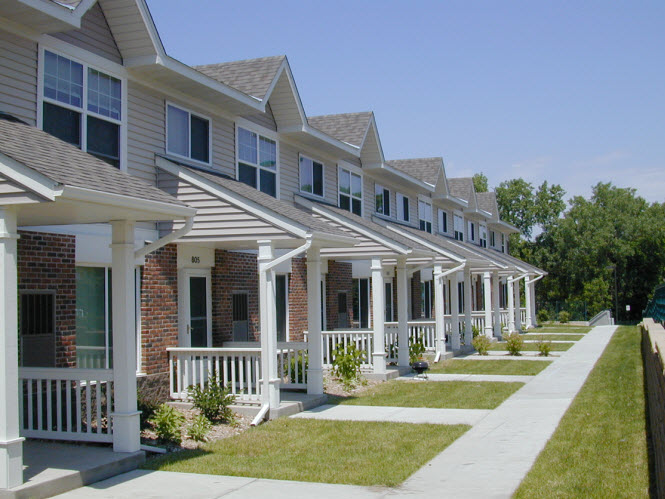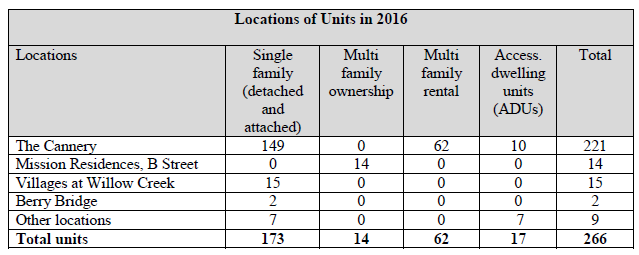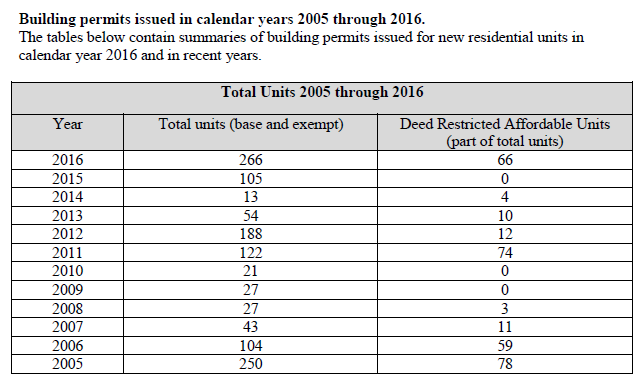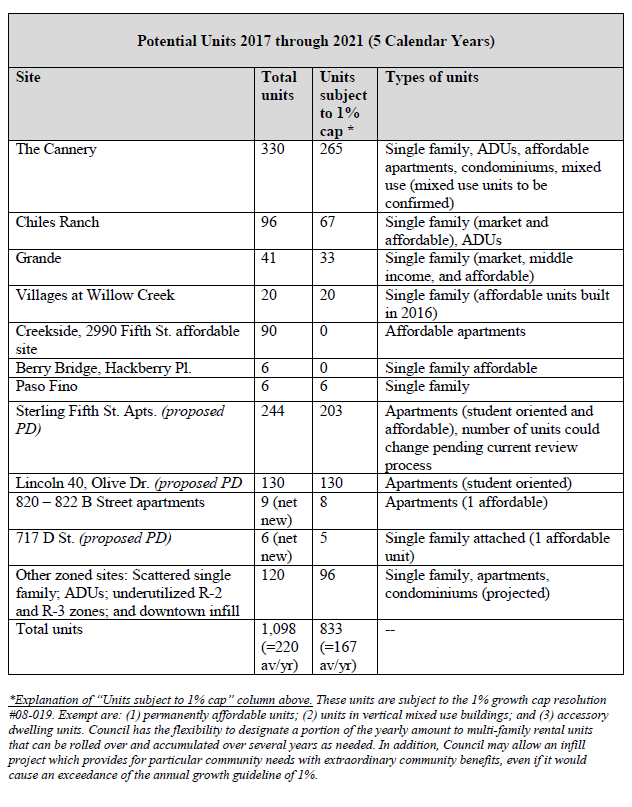
The Davis City Council will receive tonight an update on the General Plan Housing Element Progress report for the year of 2016. This is a check in with the council in order to ensure consistency with the city’s one percent growth resolution that caps growth to 260 base units, not including exempted affordable housing, ADUs (Accessory Dwelling Units) or units in mixed-use buildings
A total of 266 residential units were issued building permits in 2016, consisting of the following:


As you can see, 2016 is the first time in a decade that the city reached a numerical 260 units (including the deed restricted affordable units).

Staff believes that over the next five years, from 2017 to 2021, the city will issue roughly 1098 building permits for potential residential units.

Those 1098 potential units over the next five years would produce an annual average of 220 units per year, or 0.9 percent growth. “After excluding units that are specifically exempted by the growth cap resolution (that is, affordable units, units in vertical mixed use buildings, and accessory dwelling units), the estimate is reduced to 833 units over the five calendar years which is equal to an annual average of 167 units or an annual average of approximately 0.6 percent growth. This amount of growth is well within the 1% growth cap resolution of 2008.”
There are some potential additions to those – residential units in the proposed West Davis Active Adult community, and apartment projects such as Sterling and Lincoln40.
As noted in yesterday’s article, “the UC Davis Office of Student Housing conducted an annual Apartment Vacancy and Rental Rate Survey to collect data on vacancy and rental rates, as well as other characteristics, for rental units located within the Davis community (in City and on campus). The objective of the survey is to provide information that will help inform planning decisions on campus, and throughout the broader Davis community.”
The survey represents about 83 percent of total multi-family housing stock in Davis. They surveyed 8105 units and found that the vacancy rate was 0.2 percent whereas the previous years it was 0.2 percent and 0.3 percent. The average rent increased 5.8 percent to $1576.
In Spring of 2017, staff intends to schedule for City Council an overview of the RHNA (Regional Housing Needs Allocation) process for the next Housing Element.
In addition, on January 10, 2017, the City Council directed staff to proceed with Core Area policy/code updates and a General Plan update, in a partially-overlapping process with a total timeframe of approximately 3 to 3-1/2 years.
The city intends the process to begin first with the Core Area policy/code updates and second with a General Plan update. The General Plan update is anticipated to begin midway in the total process, depending on the progress of the Core Area updates.
—David M. Greenwald reporting






For 2013-2021 the City is supposed to permit for 422 VLI & LI units. According to these numbers, the City has so far produced 80 deed restricted units and has another 90 at Creekside. I’m not sure how much of the 20 at Willow Creek are affordable? Suppose they all are, that’s still a deficit of 232 units. Where are the rest going to come from?
30 from Sterling (if approved)
6 from Berry Bridge (if approved)
1 at B Street
60 at the Cannery
30ish at Chiles Ranch?
We are still falling short. And many of the units I’ve listed are for Moderate Income households, not VLI and LI folks.
Oh, wait, market rate ADUs count as affordable these days, don’t they? Even then, we are still falling short.
Matt, the City does not have to permit 422 VLI and LI units. All it has to do (and it has already done so) is have lots that are zoned in a category that supports the eventual building of VLI and LI units. If a lot has zoning that makes it available, it counts, regardless of whether it is built on or not.
Some vacant lots in the City have been used as part of the City’s RHNA qualification in multiple RHNA cycles. The fact that it wasn’t built on in a prior RHNA cycle only means that it rolls over into the subsequent RHNA cycle list of “qualified” lots.
Mr. Williams,
I am well aware of what you are saying, but we need to be thinking about the meaning of the RHNA in the eyes of current political leaders. Several pieces of legislation are moving through Sacramento that would put teeth behind the RHNA in terms of actual production. One of them links directly to by-right, which I suspect many Davisites would find revolting. If they don’t want by-right planning mandates from the state, we need to ensure we get to that 422 number regardless of if the number is functionally meaningless at the present time.
Also, you say, “All it has to do (and it has already done so) is have lots that are zoned in a category that supports the eventual building of VLI and LI units.” Having reviewed the adequate site inventories and Housing Elements of roughly +300 jurisdictions for my dissertation, I have never seen sites set-aside explicitly in terms of zoning for specific income categories. I cannot seem to find this on the Davis website either. Would you be so kind as to link to me this? Or are you referring to inclusionary land dedications? Or are you referring to density minimums outlined in the statutes?
Many legal experts, researchers and state officials are also taking a look at the true ability of sites set aside in Inventories vis a vis develop-ability. And not just in terms of density–we’re talking about parcel shape, ingress issues, nearby dis-amenities, etc. So if Davis is actually naming parcels in terms of–we think this one is good for VLI but this one is good for LI, that would be very interesting to look at.
Thank you!
Matt, please call me Matt. I always think of Mr. Williams as my father.
The 2013-2021 Housing Element document can be accessed at http://cityofdavis.org/city-hall/community-development-and-sustainability/planning-and-zoning/housing-element-update-2013-2021 and Section 04 Site Inventory and Local Resources contains the Units by Income Level table that lists the respective counts of VLI, LI, M and AM units.
Matt,
I don’t see assignment of income thresholds to undeveloped/underdeveloped parcels. I see income limits applied to projects underway or which have begun the entitlement process, however. These are two different things. The point I am trying to make is all the under-utilized sites for prospective development are not linked to income levels until developer interest takes hold and the city can “count” it towards its RHNA. So it could all be developed as Market Rate (or not at all). And some in the legislature would effectively penalize the city for not getting enough VLI, LI and MI units built. That’s the idea bouncing around the legislature right now.
In March 2015 the HCD notified Placerville that their housing element was not in compliance. They did not have sufficient density to provide for their potential share of affordable housing.
http://www.hcd.ca.gov/housing-policy-development/housing-resource-center/plan/he/housing-element-review-letters/edoplacerville031915.pdf
Here’s what they did about it: they rezoned two parcels to higher density. There are no development plans for those parcels. The state lists their compliance as conditional.
(http://www.bizjournals.com/sacramento/news/2015/02/19/to-satisfy-state-placerville-rezones-for.html)
SACOG cannot compel a city to annex land nor can it compel a city to build housing. Should the housing element not be in compliance, the city might not be eligible for some federal grant monies. How do these legislators you are referencing plan to compel cities to build more VLI, LI and MI units, or penalize them for failing to do so?